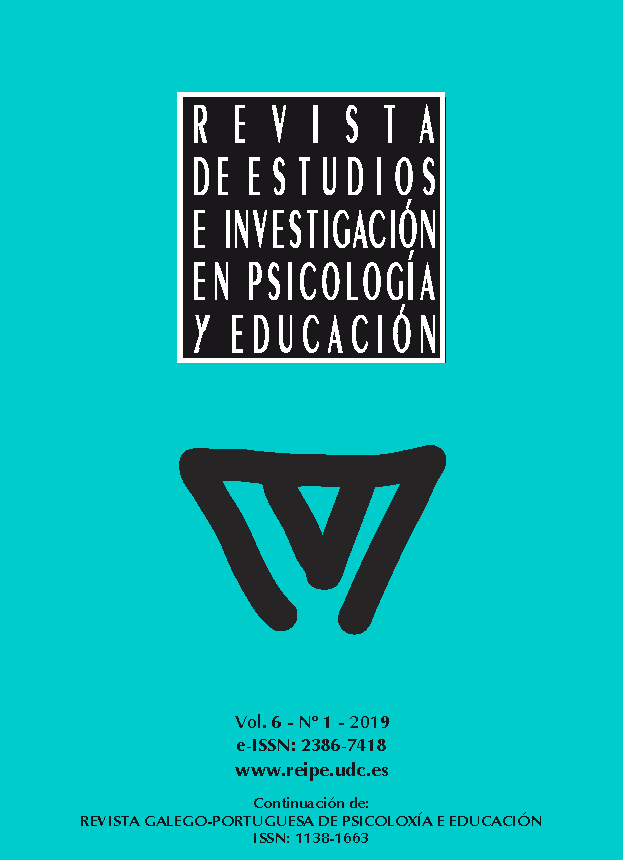Tradução e adaptação para português da Vanderbilt ADHD Diagnostic Teacher Rating Scale: um estudo piloto
Contido principal do artigo
Resumo
Este estudo integra uma investigação mais ampla, cujo propósito foi analisar o impacto da Perturbação de Hiperatividade/Défice de Atenção (PHDA) em contexto escolar, a nível académico, comportamental e social. A Vanderbilt Adhd Diagnostic Teacher Rating Scale (VADTRS) – Escala Vanderbilt de Diagnóstico de PHDA para Professores (EVDPP) - foi traduzida e adaptada para Português Europeu. 76 professores do 1.º ciclo da ilha de São Miguel (Açores) preencheram a EVDPP para 105 alunos diagnosticados com PHDA ou em avaliação, com idades compreendidas entre os 6 e os 11 anos, 85.7% são do género masculino e 14.3% do feminino. Os resultados demonstram a validade interna da escala, com alfas de Chronbach a situarem-se entre os .80 e .94 nas diferentes dimensões, corroborando outros estudos internacionais. Estes dados preliminares sugerem que a EVDPP pode ser um instrumento extremamente útil para as equipas multidisciplinares na sinalização, diagnóstico e caraterização dos principais problemas da PHDA em contexto escolar.
Palavras-chave:
Downloads
Detalles do artigo
Referências
American Psychiatric Association. (2014). Manual de Diagnóstico e Estatística das Perturbações Mentais (5.ª Ed.). Lisboa: Climepsi Editores.
Barkley, R. A., & Edwards, G. (2008). Entrevista diagnóstica, escalas de avaliação do comportamento e exame médico. In R. A. Barkley et al. (Ed.), Transtorno de Déficit de Atenção/Hiperatividade (3.ª ed.) (R. C. Costa, Trad.) (349-400). Porto Alegre: Artmed. (obra original publicada em 2006).
Brislin, R. W. (1970). Back-translation for cross-cultural research. Journal of cross-cultural psychology, 1(3), 185-216. https://doi.org/10.1177/135910457000100301
Brislin, R. W. (1976). Comparative research methodology: Cross-cultural studies. International Journal Of Psychology, 11(3), 215-229. https://doi.org/10.1080/00207597608247359
Brock, S. E., & Clinton, A. (2007). Diagnosis of attention-deficit/hyperactivity disorder (AD/HD) in childhood: A review of the literature. The California School Psychologist, 12(1), 73-91. https://doi.org/10.1007/BF03340933
Bylund, J. (2015). School Based Assessment of Attention-Deficit/Hyperactivity Disorder. Augusto Guzzo Revista Acadêmica, 1(15), 43-50.
Consultado em: http://fics.edu.br/index.php/augusto_guzzo/article/view/263
Conners, C. K. (1969). A teacher rating scale for use in drug studies with children. American journal of Psychiatry, 126(6), 884-888. https://doi.org/10.1176/ajp.126.6.884
Decreto-Lei nº 54/2018 de 6 de julho. Diário da República nº 129 – 1ª Série. Ministério da Educação. Lisboa.
DuPaul, G. J., & Jimerson, S. R. (2014). Assessing, understanding, and supporting students with ADHD at school: contemporary science, practice, and policy. School psychology quarterly: the official journal of the Division of School Psychology, American Psychological Association, 29(4), 379-384. https://doi.org/10.1037/spq0000104
DuPaul, G. J., Gormley, M. J., & Laracy, S. D. (2014a). School-based interventions for elementary school students with ADHD. Child and Adolescent Psychiatric Clinics of North America, 23(4), 687-697. https://doi.org/10.1016/j.chc.2014.05.003
DuPaul, G. J., Reid, R., Anastopoulos, A. D., & Power, T. J. (2014b). Assessing ADHD symptomatic behaviors and functional impairment in school settings: impact of student and teacher characteristics. School Psychology Quarterly: The Official Journal of the Division of School Psychology, American Psychological Association, 29(4), 409-421. https://doi.org/10.1037/spq0000095
Erskine, H., Ferrari, A., Nelson, P., Polanczyk, G., Flaxman, A., Vos, T., & ... Scott, J. (2013). Research review: Epidemiological modelling of attention-deficit/hyperactivity disorder and conduct disorder for the global burden of disease study 2010. Journal of Child Psychology & Psychiatry, 54(12), 1263-1274. https://doi.org/10.1111/jcpp.12144
Faraone, S. V., Asherson, P., Banaschewski, T., Biederman, J., Buitelaar, J. k., Ramos-Quiroga, J. A., ... & Franke, B. (2015). Attention-deficit/hyperactivity disorder. Nature Reviews Disease Primers, 1, 1-23. https://doi.org/10.1038/nrdp.2015.20
Hopkins, W. G. (2002). A scale of magnitudes for effect statistics. A new view of statistics. Acedido em julho 21, 2016, de: http://www.sportsci.org/resource/stats/effectmag.html
Langberg, J. M., Vaughn, A. J., Brinkman, W. B., Froehlich, T., & Epstein, J. N. (2010). Clinical utility of the Vanderbilt ADHD Rating Scale for ruling out comorbid learning disorders. Pediatrics, 126(5), e1033-e1038. https://doi.org/10.1542/peds.2010-1267
Marôco, J. (2014). Análise estatística com o SPSS Statistics (6.ª Edição). Pero Pinheiro: ReportNumber.
Oliveira, L., Pereira, M., Medeiros, M., & Serrano, A. (2016). PHDA: O que há de novo no DSM-5? Revista Portuguesa de Pedagogia, 49(2), 75-94. https://doi.org/10.14195/1647-8614_49-2_4
Rodrigues, A. N. (2007). Escalas revistas de Conners – formas reduzidas para pais e professores. In M. R. Simões, C. Machado, M. M. Gonçalves, & L. S. Almeida (Coord.), Avaliação psicológica: Instrumentos validados para a população portuguesa (Vol. III) (pp.203-227). Coimbra: Edições Quarteto.
Salmon, G., & Kirby, A. (2009). The role of teachers in the assessment of children suspected of having AD/HD. British Journal of Special Education, 36(3), 147-154. https://doi.org/10.1111/j.1467-8578.2009.00439.x
Shillingford-Butler, M. A., & Theodore, L. (2013). Students diagnosed with attention deficit hyperactivity disorder: Collaborative strategies for school counselors. Professional School Counseling, 16(4), 235-245. https://doi.org/10.1177/2156759X12016002S05
Schulte-Körne, G. (2016). Mental Health Problems in a School Setting in Children and Adolescents. Deutsches Ärzteblatt International, 113(11), 183-190. https://doi.org/10.3238/arztebl.2016.0183
Weyandt, L. L., & DuPaul, G. J. (2013). Assessment of ADHD. In College Students with ADHD (37-60). Springer New York. https://doi.org/10.1007/978-1-4614-5345-1_4
Willcutt, E. G. (2012). The prevalence of DSM-IV attention-deficit/hyperactivity disorder: a meta-analytic review. Neurotherapeutics, 9(3), 490-499. https://doi.org/10.1007/s13311-012-0135-8
Wolraich, M. L., Bard, D. E., Neas, B., Doffing, M., & Beck, L. (2013). The psychometric properties of the Vanderbilt attention-deficit hyperactivity disorder diagnostic teacher rating scale in a community population. Journal of Developmental & Behavioral Pediatrics, 34(2), 83-93. https://doi.org/10.1097/DBP.0b013e31827d55c3
Wolraich, M. L., Lambert, E. W., Baumgaertel, A., Garcia-Tornel, S., Feurer, I. D., Bickman, L., & Doffing, M. A. (2003a). Teachers' screening for attention deficit/hyperactivity disorder: Comparing multinational samples on teacher ratings of ADHD. Journal of Abnormal Child Psychology, 31(4), 445-455. https://doi.org/10.1023/A:1023847719796
Wolraich, M. L., Lambert, E. W., Doffing, M. A., Bickman, L., Simmons, T., & Worley, K. (2003b). Psychometric properties of the Vanderbilt ADHD diagnostic parent rating scale in a referred population. Journal of Pediatric Psychology, 28(8), 559-568. https://doi.org/10.1093/jpepsy/jsg046
Wolraich, M. L., Feurer, I., Hannah, J., Baumgaertel, A., & Pinnock, T. (1998). Obtaining systematic teacher reports of disruptive behavior disorders utilizing DSM-IV. Journal of Abnormal Child Psychology, 26(2), 141-152. https://doi.org/10.1023/A:1022673906401



